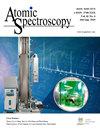同步或顺序多元素石墨炉原子吸收光谱技术:近20年来的进展
IF 2.3
2区 化学
Q1 SPECTROSCOPY
引用次数: 4
摘要
电热或石墨炉原子吸收光谱法(ETAAS或GFAAS)是测定不同基质(如食品、药品、生物标本、纳米材料、聚合物、燃料和环境介质)中元素的最广泛使用的技术之一。许多元素可以简单快速地测定,具有高精度和准确性,检测限低,成本适中。该技术也适用于固体和浆料样品的直接分析。该技术的一个关键特征是它可以执行同时或顺序的多元素分析。多年来,市场上出现了许多多元素分析仪器,主要使用线源(LS) GFAAS和高分辨率连续源(HR-CS) GFAAS。本文综述了2000年至2020年与LS-GFAAS和HR-CS-GFAAS同时或顺序多元素分析相关的出版物。主要讨论了基体、热解和雾化温度及改性剂的应用、检测限、内标准化的使用等方面的问题。最后,对LS-GFAAS和HR-CS-GFAAS技术进行了比较。本文章由计算机程序翻译,如有差异,请以英文原文为准。
Simultaneous Or Sequential Multi-Element Graphite Furnace Atomic Absorption Spectrometry Techniques: Advances Within The Last 20 Years
Electrothermal or graphite furnace atomic absorption spectrometry (ETAAS or GFAAS) is one of the most widely used techniques for determining elements in different matrices (e.g., foodstuffs, pharmaceuticals, biological specimens, nanomaterials, polymers, fuels and environmental media). Numerous elements can be simply and quickly determined with high precision and accuracy, low detection limits, and at moderate cost. The technique is also suitable for direct solid and slurry sample analysis. A crucial feature of this technique is that it can perform simultaneous or sequential multi-element analysis. Over the years, many instruments have come on the market for multi-elemental analysis using mostly line source (LS) GFAAS and high-resolution continuum source (HR-CS) GFAAS. This review covers publications from 2000 to 2020related to the simultaneous or sequential multi-elemental analysis by LS-GFAAS and HR-CS-GFAAS. Mainly the applications, the limits of detection, the use of internal standardization and other aspects regarding the matrix, pyrolysis and atomization temperatures and modifiers are discussed. Finally, a critical comparison is made between the LS-GFAAS and HR-CS-GFAAS techniques.
求助全文
通过发布文献求助,成功后即可免费获取论文全文。
去求助
来源期刊

Atomic Spectroscopy
物理-光谱学
CiteScore
5.30
自引率
14.70%
发文量
42
审稿时长
4.5 months
期刊介绍:
The ATOMIC SPECTROSCOPY is a peer-reviewed international journal started in 1962 by Dr. Walter Slavin and now is published by Atomic Spectroscopy Press Limited (ASPL). It is intended for the rapid publication of both original articles and review articles in the fields of AAS, AFS, ICP-OES, ICP-MS, GD-MS, TIMS, SIMS, AMS, LIBS, XRF and related techniques. Manuscripts dealing with (i) instrumentation & fundamentals, (ii) methodology development & applications, and (iii) standard reference materials (SRMs) development can be submitted for publication.
 求助内容:
求助内容: 应助结果提醒方式:
应助结果提醒方式:


